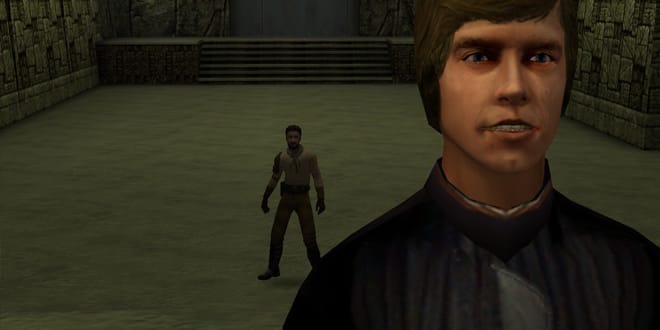When one thinks of Star Wars, gun duels aren’t the first thing that leaps to mind. The blaster rifle look and sound is iconic, but it’s not what captured peoples’ imagination at the cinema. So pairing the franchise with the first-person shooter—the most popular genre on PCs in the mid ‘90s—was an odd choice, but it gave way to what is arguably the best game franchise in the Star Wars universe: Dark Forces.
By '93, LucasArts made a mark in both the space sim and adventure genres but had yet to approach the FPS, which id Software popularized with Doom. Not one to settle for imitation, LucasArts put together one of the most talented development teams of the ‘90s. Daron Stinnett and Ray Gresko put together the most advanced FPS engine of the time, allowing multi-layered levels, 3D objects, expansive exteriors, and greater player interaction (jumping, crouching, looking up/down). Combined with Justin R. Chin's direction, this made for a game that far surpassed the “Doom clone” expectations put upon similar games of the time, such as Raven Software’s Heretic (the developer would take over the Dark Forces/Jedi Knight series in 2002).

Along with all the visceral thrills of Doom, Dark Forces (1995) added on rudimentary puzzles, complex levels requiring exploration, and mission goals—years before Goldeneye blew N64 fans away. Though technology limited the map designers in their ambitions, Dark Forces offers more realistic levels than Doom or Heretic. Levels have a flow to them that serves gameplay but also makes sense logically, such as going from a space depot to a docked space craft. Seeing Jabba’s Palace or the insides of an imperial ship are still great fan service to this day. Despite the now dated graphics, no future entry in the franchise felt quite as true to the source material. The story isn’t memorable but the great animated cutscenes and mission briefings immerse the player as mercenary Kyle Katarn working for the Rebels, taking orders from a space-muumuu-wearing Mon Mothma.
Given this was LucasArts' first outing in a genre yet to be explored by many, missteps are expected. Some levels are too labyrinthine for their own good, such as one that requires a leap of faith in an elevator shaft or the infamous sewer level that had many players putting down the game after its initial two levels. Complaints were made about the lack of lightsabers, but the real problem with Dark Forces is the weapon selection. The blaster rifle that can be obtained within the opening minutes of the game remains the best weapon until the end, given its range, fire rate and power. Weapons gathered later in the game feel gimmicky and give little reward for high risk due to splash damage.

Dark Forces is one of the best FPS games of its era, expanding on ideas introduced in Doom while pleasing Star Wars fanatics. It’s well worth playing, but be warned you may have a hard time getting it to run. A fan-made engine update Dark XL is the best way to experience the game these days, but there is a major caveat: you can’t use weapons obtained later in the game and there are a handful of game-breaking bugs. I advise playing the first half in Dark XL, then play the second half via Dosbox following Steam community guides to make the game play and look a bit more modern.
For as ambitious as the original Dark Forces was, its sequel Dark Forces II: Jedi Knight (1997) went even further in pushing Star Wars as a franchise and the FPS genre as a whole by splicing elements of RPS and exploring the possibilities that a true 3D space brings to the FPS.
Though it lacked the speed and elegance of id Software’s Quake, Jedi Knight came closer to realizing the original RPG-influenced vision of id’s masterpiece while remaining faithful to the first Dark Forces. The inclusion of RPG elements, force abilities, level-altering physics, expansive exteriors in 3D, NPCs, and advanced melee combat, made Jedi Knight stand out from other FPS games of the time. The variety of levels and combat choices still makes it an exciting, fun game to play. The speed and flexibility of combat is something missing from games today. Switching between lightsaber and blaster, while force pulling enemies’ weapons away remains incredibly satisfying.

The level and scenario design had a lot of influence on the genre. One level finds the player exploring a dim house with scripted events occurring around the corner, while another tasks the player with escaping a space shuttle falling out of orbit with large crates sliding across rooms and physics rendering walls climbable. LucasArts pushed its SITH engine to its limits, sometimes to a fault.
It’s a shame then that the cryptic level design—a flaw shared among all entries in the series to varying extents—sours the experience. Even with diligent and thorough exploration, it can often be a frustrating task to navigate through these levels. It often made me want to put the game down and never come back. This feeling was felt tenfold in the opening sections that don’t supply the player with enough ammo to make it through, especially on hard. This is made worse due to the blaster rifle’s random spread that doesn’t allow for skill shots (a mouselook option is included but clearly the game was made with auto-aim in mind).
The lightsaber combat is fun when you are mowing down stormtroopers, but it becomes a joke against bosses where there is little strategy to apply: you just circle around, swing and repeat. The force powers, which vary depending if you choose a light or dark path, are fun but eventually become game-breaking. In later sections, I’d use Force Protection, which made me invincible for the majority of a level. Given how excruciatingly difficult the game is on hard, I felt I deserved it and would apply every cheap trick available.

Jedi Knight put story at the forefront featuring impressive CG for the time and campy FMV scenes. Due to fan complaints of the original, Katarn is retconned as a force-sensitive jedi in the making. The player can steer toward the light or dark path by killing NPCs (merchants and robots that populate levels). It's not the most robust skill tree or player choices, but Deus Ex and games of its ilk were years away at the time. The flaws of Jedi Knight's level design keep it from reaching the timelessness of the original, but it's a great deal of fun when it isn't deterring the player with cheap deaths or confusing layouts.
The Mysteries of the Sith (1998) expansion released a year after Jedi Knight is equally worthwhile. It has the same strengths and flaws of the main game, but it’s equally long and ambitious (expansions were a different beast in the ‘90s). Players have the benefit of starting with a lightsaber and basic force powers, which is nice. There isn't much that puts it apart from the main campaign, and with Half-Life and Sin's release, it quickly became forgotten.
It would take five years for Jedi Knight to get a proper sequel and, for reasons that aren’t clear, LucasArts didn’t feel confident in developing it, passing the torch to Raven Software instead. From adapting Star Trek to a mercenary's real life experiences into classic FPS games, LucasArts couldn’t have picked a better developer for the task.
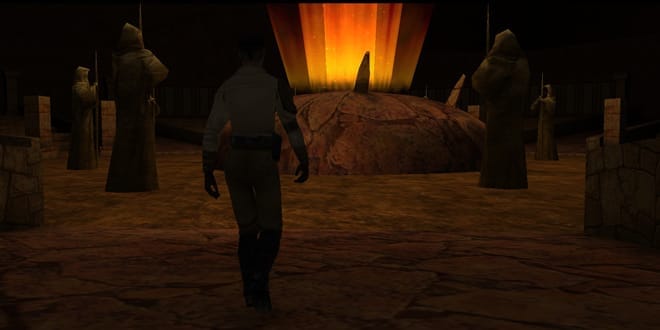
I had never played Star Wars Jedi Knight II: Jedi Outcast (2002) before but expected greatness given both the developer and series’ pedigree. It was a crushing and cruel experience then to discover what is possibly the worst entry in both Dark Forces’ and Raven’s FPS catalog. It's a game plagued by a myriad of problems that could have been avoided given an extra month or two of development.
By 2002, Lucas had stopped being so protective of the franchise (some may say to the extent of tarnishing it), which allowed Raven to be far more free to explore the world of Star Wars than the original games. Lando Calrissian and Luke Skywalker make lengthy appearances alongside memorable locations from the films, such as Cloud City. While Raven’s efforts at fan service are appreciated, the game ends up feeling hollow as a result. It is neither a fun ride through the world of the original films like Dark Forces nor an interesting story in the expanded universe like the first Jedi Knight. Billy Dee Williams reprises his role as Lando, but he is clearly phoning in lines, adding to the soullessness of the whole thing.
Presentation and story weren’t what sold me on the previous games, so I’m okay with this. What I’m not okay with is the game being significantly flawed in almost every other facet. The levels, for the most part, take place in warehouses and ships that all blend together with boring greys and browns. For as bad as the first Jedi Knight’s levels were, Jedi Outcast features some of the worst level design I’ve ever seen in a FPS. Almost every single level had me getting lost and stuck multiple times, discovering the majority of secrets before I found the main path in the least expected area (such as a vent in the ceiling in a random room). At least when I found the solution in previous games, I felt clever for solving a puzzle or exploring. In Jedi Outcast, I'm left scratching my head why I'm finding secrets easier than the main path. All of this is made worse by the lack of a map, which was a feature in the previous games.
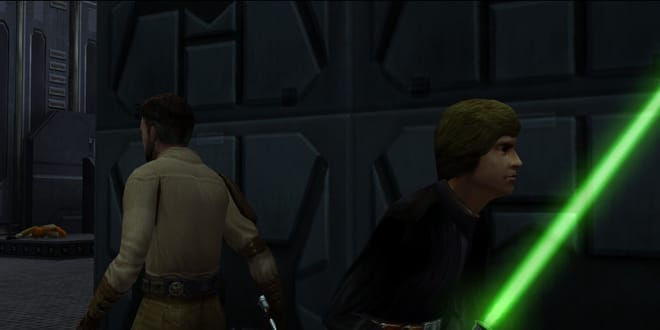
Though the lightsaber and force abilities saw a significant upgrade, the shooting of Jedi Outcast is awful. I could stand in front of a stormtrooper and unload my gun, while bullets magically dance around him and the ones that land provide no visual/audio feedback. Now imagine how much worse this is when the AI is strafing around and the broken hitboxes fail to cooperate with the player. Even firing guns—the foundation of the FPS—is joyless in Jedi Outcast. The standard blaster rifle lacks accuracy while the sniper rifle unzooms if the player moves and has such a long delay that it’s useless in most situations. Later guns feel weak and inaccurate, making a heavy reliance on melee combat non-optional.
The game gets better as force powers become more powerful. Pull weapons away from a group of foes and cutting them all down has never been more satisfying. Even this is spoiled, however, with scenarios that get progressively worse. Escort missions lead to forced stealth sections which leads to a terrible vehicle section, an anti-gravity area that is maddening, and a final boss fight that feels random: one try I can't get a single hit in, while the next I beat him in two hits. Around every corner, Jedi Outcast reminds you of all the terrible elements present in early '00s games while losing the core fundamentals that made the first two series entries fun.
Jedi Outcast sounds like a trash fire but the sad thing is that it is on the cusp of greatness. It’s no surprise then that Raven put out its other first big flop the same year with Soldier of Fortune II. Both games share key members of development staff along with the problems that come from rushing a game, failing to polish before release. While Raven never returned to the Soldier of Fortune franchise, it did take another stab at Star Wars.
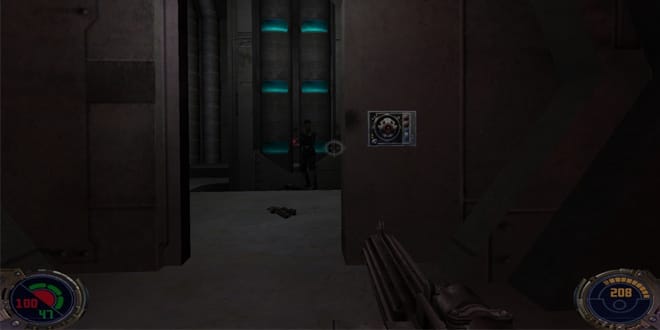
With Star Wars Jedi Knight: Jedi Academy (2003) that layer of polish was applied, making the best 3D entry in the series and even better than the first Dark Forces depending on the day of the week. Subtle changes were made to the engine, fixing all the above listed complaints alongside visual upgrades. Shooting feels fantastic now, for the most part. Guns remain under-powered, but this is balanced by further improving lightsaber combat. Along with a new layer of polish comes some of the most innovative levels and mission design in the series.
The game is broken up between sequences that allow the player to choose five levels in any order (the fifth is optional), while required story-driven missions divide these sections. The main plot is forgettable and fans of the Kyle Katarn saga will be disappointed by him being demoted to side character, but all of this is made up for by the freedom it brings the game to explore different scenarios.
Each mission is like its own exciting slice of Star Wars fan fiction. One mission finds you escorting prisoners away from a raging rancor while another finds you escaping a prison yourself without your lightsaber. Even the vehicle and experimental levels—one has the player jumping from platform to platform, avoiding sand worms below the surface—are good this time around. The variety and creativity of these missions continues to deliver until the game’s finale, eight or so hours later. If you play only one game in the series, Jedi Academy should be it.
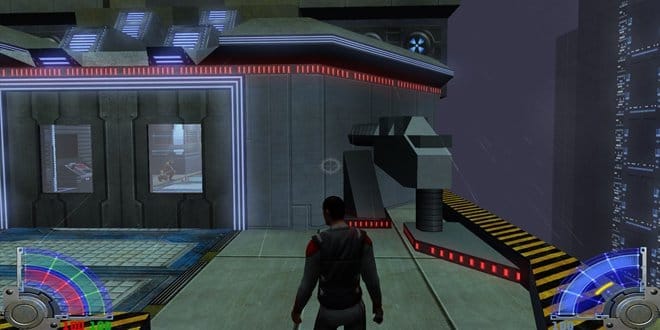
Jedi Outcast and Jedi Academy both scale gracefully to modern hardware on PC, allowing for high resolution widescreen and even 120+ hz support. Stilted, puppet-like animation aside, these games hold up fairly well. Even better, they run on a modified Quake 3 Engine so you can bunnyhop your way through these maps like a true jedi!
Multiplayer and fan mods were a large drawing point for these games, but my experience is limited to single player. Between revisiting old classics and finding a new favorite in Jedi Academy, I’ve had an enormous amount of fun playing through this series. With Visceral Games making a new single-player Star Wars game, written by Uncharted’s Amy Hennig, I hope the studio also pays a visit the the Dark Forces/Jedi Knight series. It’s one of the few licensed franchises that manages to be innovative within its genre while remaining faithful to its source material. Though its flaws stand out more than ever, so do its strengths.
For any wanting to take the plunge, I advise buying Dark Forces I & II on GOG and getting the rest on Steam. Steam Guides and PC Gaming Wiki are valuable resources for bringing the games up-to-date graphically and controls-wise. What are your memories with the Dark Forces series? What would you like to see from a new Stars Wars game?
Review Summary
The Dark Forces series is one of the few licensed franchises that manages to be innovative within its genre while remaining faithful to its source material. Though its flaws stand out more than ever, so do its strengths.
(Review Policy)Have a tip, or want to point out something we missed? Leave a Comment or e-mail us at tips@techraptor.net
